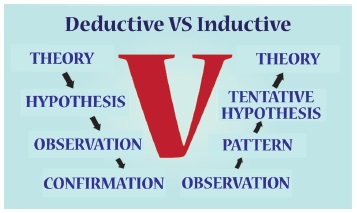Chapter: 11th Economics : Chapter 1 : Introduction To Micro-Economics
Economics: Its Methods, Facts, Theories and Laws
Economics:
Its Methods, Facts, Theories and Laws
1. Methods of Economics: Deduction and Induction
Like any
other science, Economics also has its laws or generalisations. These laws
govern the activities in the various divisions of Economics such as
Consumption, Production, Exchange and Distribution. The logical process of
arriving at a law or generalization in a science is called its method.

Economics
uses two methods: deduction and induction.
a. Deductive Method of Economic
Analysis
It is
also named as analytical or abstract
method. It consists in deriving conclusions from general truths; it takes few
general principles and applies them to draw conclusions. The classical and
neo-classical school of economists notably, Ricardo, Senior, J S Mill, Malthus,
Marshall, Pigou, applied the deductive method in their economic investigations.
Steps of Deductive Method
Step 1: The analyst must have a clear and
precise idea of the problem to be inquired
into.
Step 2: The analyst clearly defines the
technical terms used in the analysis. Further, assumptions of the theory are to be precise.
Step 3: Deduce hypothesis from the
assumptions taken.
Step 4: Hypotheses should be verified
through direct observation of events in the real world and through statistical methods. (eg) There exists an
inverse relationship between price and quantity demanded of a good.
b. Inductive Method of Economic Analysis
Inductive method, also called empirical method, is adopted by the “Historical School of Economists”. It involves the process of reasoning from
particular facts to general principle.
Economic
generalizations are derived in this method, on the basis of
1.
Experimentations;
2.
Observations; and,
3.
Statistical methods.
Step 1: Data are collected about a
certain economic phenomenon. These are systematically
arranged and the general conclusions are drawn from them.
Step 2: By observing the data,
conclusions are easily drawn.
Step 3: Generalization of the data and
then Hypothesis Formulation
Step 4: Verification of the hypothesis (eg.Engel’s law)
According to Engel’s Law “The proportion
of total expenditure incurred on food items declines as total expenditure
[which is proxy for income] goes on increasing.”
Economists
today are of the view that both these methods are complementary. Alfred Marshall
has rightly remarked: “Inductive and Deductive methods are both needed for scientific thought, as the right and left
foot are both needed for walking”.
2. Economics:
Facts, Theories
Using the
methods, the economist observes facts, such as, changes in the price of a
commodity. Similarly, the quantity demanded of that commodity also varies. And
he observes these movements and comes up with a theory that these two movements
are inversely related, i.e., when the price increases, the quantity demanded of
that commodity decreases and vice versa. Thus, he formulates his theory of
demand.
He tests
his theory by collecting further facts and when his theory stands the test of
time and obtains universal acceptance, the theory is raised to the status of a
law.
3. Nature of Economic Laws
A Law
expresses a causal relation between two or more than two phenomena. Marshall
states that the Economic laws are statement
of tendencies, and those social laws, which relate to those branches of
conduct in which the strength of the motives chiefly concerned can be measured
by money price.
In
natural sciences, a definite result is expected to follow from a particular
cause. In Economic science, the laws function with cause and effect. The
consequences predicted by the data, necessarily and invariably follow.
However,
Economic laws are not as precise and certain as the laws in the physical
sciences. Marshall holds the opinion that there are no laws of economics which
can be compared for precision with the law of gravitation.
Importance of Micro Economics
·
To understand the operation of an
economy
·
To provide tools for economic
policies
·
To examine the condition of economic
welfare
·
Efficient utilization of resources
·
Useful in international trade
·
Useful in decision making:
·
Optimal resource allocation
·
Basis for prediction
·
Price determination
A
physical scientist carrying out controlled experiments in his laboratory can
test the scientific laws very easily by changing the conditions obtaining
there. Changes in Economics science cannot be brought about easily. As a
result, prediction regarding human behaviour is likely to go wrong. There are
exceptions to the Law of Demand. Thus, economic laws are not inviolable.
As
unpredictability is invariably associated with the economic laws. Marshall
compares them to the laws of tides. Just as it cannot be predicted and said
with certainty that a high tide would follow a low tide, unpredictability
prevails in Economics. Human behaviour is volatile. Economic laws are not
assertive but they are indicative. The Law of Demand, for example, states that
other things remaining the same, the quantity demanded of a commodity
increases, as its price decreases and vice versa.
The use
of the assumption ‘other things remaining the same’ (ceteris paribus) in
Economics makes the Economic laws hypothetical. It might be argued that the
laws in other sciences can also be called hypothetical. It should be admitted
however that in the case of Economics, the hypothetical elements in its laws
are a little less pronounced than in the laws of physical sciences.
But since
money is used as the measuring rod, laws in economics are more exact, precise
and accurate than the other social sciences. As the value of the measuring- rod
money is not constant, there is always an hypothetical element surrounding the
laws of Economics.
Some
economic laws are simply truisms. For example, saving is a function of income.
Another
example of truism is: human wants are unlimited.
Related Topics